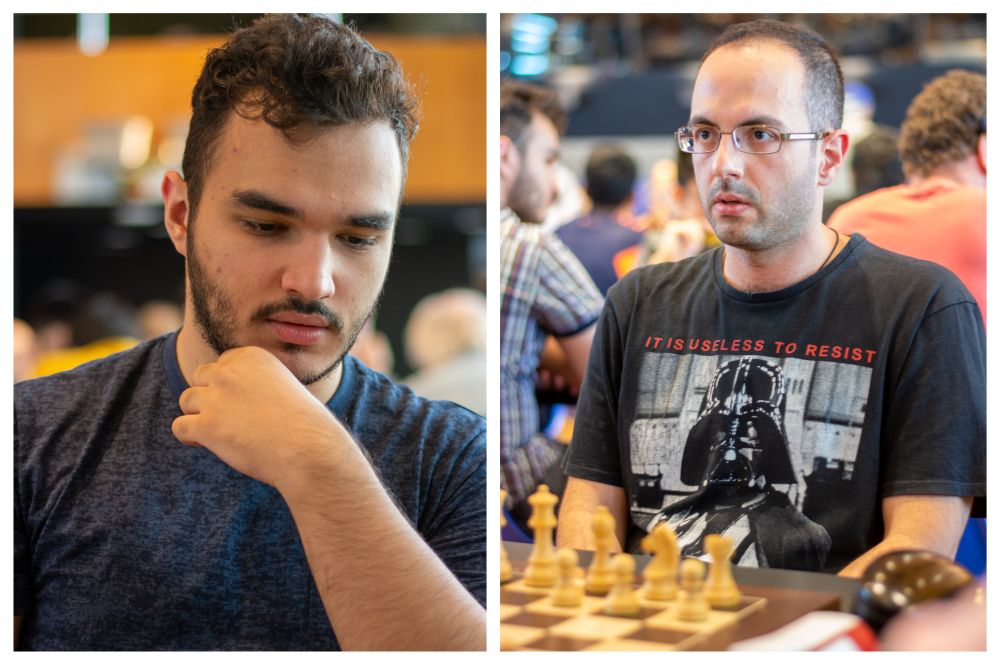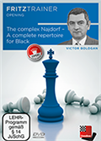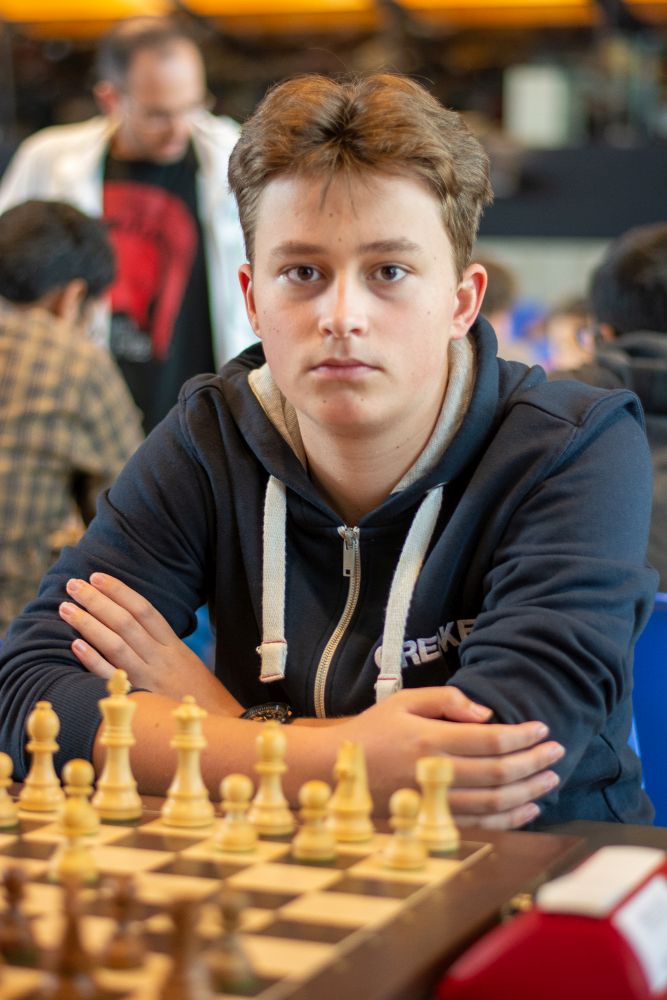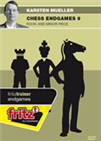Terrific Tabatabaei sole first
The Masters Open of the Biel festival heated up significantly after the rest day, as the lead changed hands consistently and finally Mohammad Amin Tabatabaei of Iran put in that extra bit of push towards the final stretch to win the tournament. (You have to remember that he was on 4.0/5 when we left him last, after losing in the third round against Greek GM Athanasios Mastrovasilis — game given below) Consider this sequence:
- Jeffery Xiong, Ante Brkic and Erigaisi Arjun on lead with 5.0/6. (Tabatabaei follows on 4½/6).
- Tabatabaei, Iturrizaga, Donchenko, Manuel Petrosyan too join them for a Seven (!) way tie on 5½/7.
- Tabatabaei shoots ahead with 6½/8.
- Tabatabaei wins the event with 7.0/9, after a (lacklustre) final round with many draws.

Tabatabaei was shocked as early as round 3 by Greek GM Athanasios Mastrovasilis | Photo: Peter Steffen / Biel Chess Festival
First of all, the game which Tabatabaei lost in the third round had a beautiful geometry:
 The aim of these Dvd's is to build a repertoire after 1.c4 and 2.g3 for White. The first DVD includes the systems 1...e5, the Dutch and Indian setups. The second DVD includes the systems with 1...c5, 1...c6 and 1...e6.
The aim of these Dvd's is to build a repertoire after 1.c4 and 2.g3 for White. The first DVD includes the systems 1...e5, the Dutch and Indian setups. The second DVD includes the systems with 1...c5, 1...c6 and 1...e6.
9.0-0 might have been played for the surprise value, more than anything. 9.♗d4 ♛b4+ 10.♘bd2 ♛xc4 11.♘xc4 ♝b4+ 12.♘fd2 leaves White with more than enough compensation for the pawn.
12.♘a3? inexplicable — after bottling up black's queen, it is logically expected that white would want to swallow her instead of letting her escape. White should have gone for the eccentric looking 12.♘e1! (Threatening ♗f3 trapping the queen) ♛h5 13.a3
It is still a glorious mess with white having the initiative but black has better resources now.
This looks obvious, but overlooks a crucial tactical detail, which white probably overlooked.
Looks straightforward, but look for a Geometry here for black! 14...♞d3 this intermezzo seals the day for Black. 15.♕c3 ♝xa3 16.♗xh8 ♝b2! The point! The black bishop does a reverse turn with ♝f8xa3-b2xh8 to save the day for black! Not every day that you see such an artistic straight lines on the board.
Round 6
The top seeded Jeffery Xiong’s win over Alexander Donchenko helping him to join the lead was typical of the American in many ways: he showed his preparation in the opening with a typical move of the modern computerised times, and the end of the game was a flurry of ‘shots’ which Xiong was to show more in the ensuing rounds.
 When choosing an opening repertoire, there are days when you want to play for a win with Black, when you want to bear down on your opponent’s position with a potentially crushing attack. The Najdorf is perfect for just such occasions. Strategy, combinations, attack and defence, sacrifices and marvellous manoeuvres — exciting chess is all about the Najdorf!
When choosing an opening repertoire, there are days when you want to play for a win with Black, when you want to bear down on your opponent’s position with a potentially crushing attack. The Najdorf is perfect for just such occasions. Strategy, combinations, attack and defence, sacrifices and marvellous manoeuvres — exciting chess is all about the Najdorf!
Top seed Jeffery Xiong beat Alexander Donchenko in round 6 | Photo: Peter Steffen / Biel Chess Festival
Needless to say, this was popularised by 'one evil dude' Parimarjan Negi, who was writing books on how to win with white pieces against all existing openings which the whole world follows!
A new move in this position. In a way, we can call this an example of modern opening preparation — watch how the game unfolds.
Now, 13.g5 was not a completely correct move, but to exploit it, black had to respond with way too much creativity here. 14...♜c8 and black doesn't find it, though he too has an evil idea here. Believe it or not, black's best line of play is a completely 'computerised' one here: 14...b4!? 15.axb4 a5!? 16.bxa5 ♛xa5 17.♘b3 ♛b6 and the open kingside gives better prospects for black in the long run. But I wouldn't be surprised if Xiong had prepared it all before: after all, it is not easy to play like this over the board, and white could have found a way to hold on to things dear in his preparations before the game.
White's idea behind this move is really cute. A routine white move would have shown black's hand: 15.♗g2 ♛b6 16.♔b1 ♜xc3! The point behind 14...♜c8. Now you must be able to see the idea behind White's 15th move!?
That's it. White kind of stops Black's play on the queenside, and enjoys a certain 'advantage of a defender' here. Black finds it difficult to do much.
22...Kf8?? More than anything, this is that exact kind of position where Xiong excels. Try to see what Xiong saw here.
25.♖xe4! Very nice — it is indeed not an easy job to see the whole variation. On the other hand, white must have seen the whole variation for it to work to the end.
26.f5! Cool! a simple pawn push at the end of a series of sacrifices is always a tactical delight! 26...♜xh4 27.fxe6 ♛c7 28.♖f1+ ♜h4 29.♕h6+ 1-0
There was a cute point by young Vincent Keymer in this round:
Black could probably have defended the position with 23...♛f5 here, but Keymer showed some creativity here: 23...♛xf3!? 24.gxf3 [24.♖xe8+?? ♞xe8-+ as the white queen is attacked too] 24...♜xe1+ 25.♔g2 ♝xb3 26.axb3 g6 and black went on to hold the game, as white doesn't have any breaks and the lone queen can't do much against Black's embargo with the knight and rook:

The German wunderkind IM Vincent Keymer | Photo: Peter Steffen / Biel Chess Festival
Round 7
Nothing much happened in the round between the leaders, which enabled three from lower boards to join them on lead. Young Keymer played beautiful positional chess to outplay the higher rated Iturrizaga Bonelli, only to see it all vanish under pressure:
After an uneven opening and early middlegame, things finally started happening here: 26.♔g2 White has a specific idea here: to exchange light bishops and thus gaining a little more edge due to dominating light squares on the kingside. 26...♛b6?! Black should have been alert to white's threat and played 26...h5 Positional alertness! Watch out for Black's play sticking to basics here 27.♖xc8 ♜xc8 28.♘e3 ♞g4 more basics: stopping the exchange of light bishops 29.♘df1 ♜e7! even more basics: activating the sleeping piece! 30.♘f5 ♝xf5 31.exf5 ♞f8 with a complicated position, where black still holds the balance.
In the game we saw 27.♘e3 ♝xh3 28.♔xh3 ♛b7 29.♔g2 ♛d7 30.f3 ♞e7:
31.♘b1! The point, white finds a target in the weak b5
43.♘cd1+- Black's play on the kingside seems to have stopped - what can go wrong for White here?
57.♕c2?? Throwing the advantage away. In certain ways, it is even more difficult to hold your nerves with a winning position if the opponent has even a semblance of threats. 57...gxf5 58.gxf5
58...♞xd5!! with this elegant sacrifice, black gains a draw... atleast 59.exd5 ♛xd5 60.♔g1 ♞f3+ 61.♔f2 ♞d4 62.♖c8+ ♚g7
63.♕c7+?? White goes berserk in the second time control. 63.♖c7+ ♚h8 64.♖c8+ would have been a draw. 63...♚h6 64.♕c1+ ♚h5-+ 65.♖c3 ♜g8 66.♕e3 ♛h1 0-1
Donchenko and Tabatabaei had smooth wins over Aryan Chopra and Andrei Shchekachev respectively to become joint leaders.
Round 8
The crucial round, when an important game which proved to be the tournament decider went in favour of Tabatabatei:
12.♖fd1 A quiet position battle seems to be on the cards. Nothing special happening - the position should be level. 12...cxd4 13.♘b5 This position is not as great as it looks, if you visually get prejudiced by Black's isolated pawn on d5. After all, the white knight on e5 is not comfortably placed. 13...♞c5 14.♕f3 [14.♕xd4 ♞e6 15.♕d2 ♞xf4 16.gxf4] 14...♞ce4 15.♘d3 ♜c8?! There was no need to throw away a7.
16.♗h3? There was no reason not to grab the a7! 16...♜c4 17.♘e5?? His strength becomes his weakness here: Xiong looks for activity, overlooking a crucial detail in the position. Better was 17.b3 ♜c3! The point!
18.♖ac1 ♝c5! 19.♘xc3 dxc3 20.♘xc5 bxc5 21.♖xc3 ♞xc3 22.♕xc3 ♞e4 and black is still better, but only slightly.
Suddenly, black has big threats: ...g7-g5 and ...a7-a6 18.e3?? ♜xe5! 19.♗xe5 ♞g5 20.♕f5 ♞xh3+ 21.♕xh3 dxe3-+ 22.♗d4 ♛e8 23.♗xc5 bxc5 24.♘d6 exf2+ 25.♔f1 ♜c2! 0-1
In certain ways, Xiong was a victim of his own style here. In what could have been a typical positional maneuvering game, he tried to impose his will with active play, and was punished instantly by Tabatabaei. As it turned out, this top board game turned out to be the most crucial game of the event.

The legendary Gata Kamsky | Photo: Peter Steffen / Biel Chess Festival
Gata Kamsky is a legend in his own way, who has fought battles with the legends of Karpov and Anand in his younger days. He has a remarkable board presence in the tournament hall, which you cannot help admiring. In this round, he showed glimpses of his depth of chess understanding in the game against young Erigaisi Arjun, who had hurt his feet during his flight journey to Europe and was visibly not sitting comfortable at the board throughout the tournament:
 Endings with rook and minor piece against rook and minor piece occur very frequently, even more often than rook endings, yet there's not much literature on them. This endgame DVD fills this gap. The four different material constellations rook and knight vs rook and knight, rooks and opposite coloured (and same coloured ) bishops and rook and bishop vs rook and knight are dealt with. In view of the different material constellations Karsten Mueller explains many guidelines like e.g. "With knights even a small initiative weighs heavily".
Endings with rook and minor piece against rook and minor piece occur very frequently, even more often than rook endings, yet there's not much literature on them. This endgame DVD fills this gap. The four different material constellations rook and knight vs rook and knight, rooks and opposite coloured (and same coloured ) bishops and rook and bishop vs rook and knight are dealt with. In view of the different material constellations Karsten Mueller explains many guidelines like e.g. "With knights even a small initiative weighs heavily".
A quiet opening in Kamsky's style, but now he brings his speciality to the board. 15.b4!? The engine doesn't believe in it, but the move is pure Kamsky: a pawn sacrifice for piece play on the queenside, which may be a rarity in modern chess. One does see such ideas during a kingside attack, but how does it work here?! The answer lies on the black bishop at h7, which will remain a silent spectator through the game.
Having given up the pawn and controlling the a-file, Kamsky exchanges the queens too!
Once again, engines do not believe in White's play, but please do observe the clarity of thought. 24...b4 Somewhere around here, black doesn't find the best way to play. 24...♝g6 was a nice positional move, hoping to bring the bishop back into the game at some point, either with a future ...♞f6-d7 & f7-f6, or from h5 if the situation presents itself. Somewhere around here, black doesn't find the best way to play. 24...♝g6 was a nice positional move, hoping to bring the bishop back into the game at some point, either with a future ...♞f6-d7 & f7-f6, or from h5 if the situation presents itself.
Black is still fine, but that is only if you employ engines to analyse the position! Imagine black being under pressure for about 20 long moves inching towards the time control: he finally cracks here. 35...♝xa5 36.♖xb8 Once again, white has an edge mainly due to the black bishop on g6, but it doesn't look anything serious 36...♝c3 37.♗xc3 ♜xc3 38.♔f2 ♜c7 39.g4 f6 40.♖d8 f5?
The proverbial 40th move howler — haven't you observed when most of the 'lashing out' pawn advances almost always turn out to be positional mistakes?! A typical 'freeing' push when your whole being screams for 'release' of tension. Black could have still sat still with his hands under his bottom, but not an easy thing to do over the board being under pressure 40...♜e7. 41.♔e3 Someone's is coming to take over the central command! 41...♜f7 42.♖d6 fxg4 43.♗xg4 ♝f5 44.♗xf5+ exf5 45.h4 ♜e7+ 46.♔f3 h5 47.♖xd5 g6 48.♖e5 ♜d7 1-0
A typical vintage Kamsky positional ‘squeeze’! This meant that Gata was now in striking distance to the top honours going into the last round.
Round 9
Thus, it looked like a mouthwatering last round was on the cards, as Tabatabaei was on sole lead with 6½/7, with six of them following close behind at 6.0/7, only to see a damp squib in the last round as the top three boards ended in quickly agreed draws!

Top 3 boards ended up in a quick draw in the final round | Photo: Simon Bohnenblust / Biel Chess Festival
This left Shyam Sundar a chance to tie for the first with Tabatabaei on the top with a win, but he ran into a Xiong specialty:
11.♘a3 After an eccentric opening, things seem to have settled down, but Shyam handles the development not in an ideal way. 11...♛e6?! [11...♞e7 12.♘c4 ♛c5 13.♗e3 ♛b4 +=]
15...h5? 16.♘cxe5! Bam! Try to work out the variations here — it's fun! 16...♞xe5 17.♗c3! Excellently calculated. The positional factors which makes this tactic works are:
- Black's Bishop at c5 [Remember Nunn's 'Loose Pieces Drop Off?']
- Black's pawn at c6 which will open the doors for the black king and
- King in the centre (of course, the basic stuff)
Thus, Tabatabaei went on to win the tournament sole at 7.0/9.
The tournament also produced two International Master norms, for Jianwen Wong of Malaysia and 12-year old Pranav Anand of Bangalore, India. This is Pranav’s second IM-Norm, the first one coming from the Rilton Cup 2018-19. While Wong had a short draw with GM Vishnu Prasanna in the final round, Pranav Anand defeated veteran IM Anatoly Donchenko (2249) of Germany.

FM Pranav Anand performed at 2452 and gained 25 Elo rating points on his way to secure his 2nd IM-norm | Photo: Simon Bohnenblust / Biel Chess Festival 2019

Jianwen Wong of Malaysia performed at 2465 and increased his Elo rating by 38 points to earn his IM-norm | Photo: Simon Bohnenblust / Biel Chess Festival 2019
All games
Final Standings
| Rk. |
SNo |
|
Name |
FED |
Rtg |
TB1 |
TB2 |
TB3 |
| 1 |
10 |
GM |
Tabatabaei M.amin |
IRI |
2601 |
7,0 |
47,5 |
355,0 |
| 2 |
3 |
GM |
Kamsky Gata |
USA |
2673 |
6,5 |
49,0 |
358,5 |
| |
8 |
GM |
Donchenko Alexander |
GER |
2615 |
6,5 |
49,0 |
358,5 |
| 4 |
19 |
GM |
Brkic Ante |
CRO |
2573 |
6,5 |
48,0 |
359,5 |
| 5 |
1 |
GM |
Xiong Jeffery |
USA |
2691 |
6,5 |
48,0 |
353,5 |
| 6 |
13 |
GM |
Petrosyan Manuel |
ARM |
2592 |
6,5 |
46,5 |
361,0 |
| 7 |
6 |
GM |
Iturrizaga Bonelli Eduardo |
VEN |
2625 |
6,5 |
46,5 |
348,0 |
| 8 |
4 |
GM |
Salem A.R. Saleh |
UAE |
2672 |
6,5 |
46,0 |
351,5 |
| 9 |
22 |
GM |
Puranik Abhimanyu |
IND |
2550 |
6,5 |
44,5 |
365,5 |
| 10 |
18 |
GM |
Moussard Jules |
FRA |
2576 |
6,5 |
42,0 |
351,5 |
| 11 |
26 |
GM |
Shchekachev Andrei |
FRA |
2531 |
6,5 |
42,0 |
343,5 |
| 12 |
5 |
GM |
Jumabayev Rinat |
KAZ |
2633 |
6,0 |
45,5 |
334,5 |
| 13 |
11 |
GM |
Gopal G.N. |
IND |
2594 |
6,0 |
45,0 |
342,0 |
| 14 |
30 |
GM |
Mastrovasilis Athanasios |
GRE |
2518 |
6,0 |
44,5 |
348,5 |
| 15 |
31 |
IM |
Keymer Vincent |
GER |
2513 |
6,0 |
44,0 |
353,0 |
| 16 |
12 |
GM |
Santos Latasa Jaime |
ESP |
2594 |
6,0 |
44,0 |
349,0 |
| 17 |
25 |
GM |
Erigaisi Arjun |
IND |
2531 |
6,0 |
43,5 |
357,0 |
| 18 |
29 |
GM |
Shyam Sundar M. |
IND |
2520 |
6,0 |
42,0 |
347,0 |
| 19 |
21 |
GM |
Aryan Chopra |
IND |
2553 |
6,0 |
42,0 |
345,5 |
| 20 |
14 |
GM |
Vaibhav Suri |
IND |
2591 |
6,0 |
41,5 |
344,5 |
Complete standings
Links






























